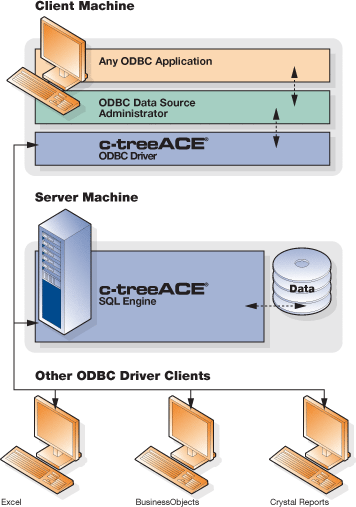Developer Guide |
|
FairCom ODBC |
|
Audience: |
Developers |
Subject: |
Configuring and using an ODBC driver to connect to a FairCom DB Database (for older version, see “Legacy Documentation”) |
Copyright: |
© Copyright 2025, FairCom Corporation. All rights reserved. For full information, see the FairCom Copyright Notice. |
This document introduces ODBC, the FairCom DB SQL ODBC driver, and how they work together to provide access from a wealth of desktop tools to FairCom DB SQL environments:
In V11 and later, FairCom DB SQL ODBC drivers for Unix are available on AIX and Solaris (Sparc) platforms.
The Open Database Connectivity (ODBC) interface from Microsoft has emerged as the standard mechanism for client applications to access data from a variety of different sources through a single interface. Users of applications supporting ODBC merely select a new database from a point-and-click menu to connect transparently to that data source.
To become accessible from ODBC client applications, database environments must provide software, called a driver, on the client system where the application resides. The driver translates the standard ODBC function calls into calls the data source can process, and returns data to the application. Each data source provides a driver on the client system for applications to use to access data from that source.
The FairCom ODBC Driver extends this plug-and-play interoperability to the FairCom Database Engine. It allows any Microsoft Windows tool or application that supports the ODBC call library to easily use c-tree as a data source. With it, applications based on tools such as Visual Basic can include c-tree as a data source.
The ODBC interface specifies two major components:
ODBC drivers fit in as a layer of “middleware” in the ODBC architecture. The ODBC architecture includes the following layers:
Application
An ODBC application is any program that calls ODBC functions and uses them to issue SQL statements. For example, many vendors have added ODBC support to their existing Windows-based tools, such as PowerBuilder™ and Impromptu®, so those tools can use ODBC for data access.
ODBC Driver Manager
A Microsoft-supplied dynamic-link library (DLL) that routes calls from an application to the appropriate ODBC driver for a data source. An application sees the ODBC driver manager and a driver as a single entity that processes requests to a particular data source. The ODBC driver manager loads the requested driver in response to an application’s call to the ODBC SQLConnect() or SQLDriverConnect() functions.
ODBC Driver
A dynamic link library (DLL) that processes ODBC function calls for a specific data source. The driver connects to the data source and translates the standard SQL statements into syntax the data source can process. It also returns any requested data to the application. There are ODBC drivers for every major database system.
Data Source
The combination of a database system, the operating system it uses, and any network software required to access it. (ODBC defines a database system (DBMS) as any vendor’s implementation of a data access system that provides an SQL interface.)
The following figure shows the components involved in a typical ODBC environment.
